
Published: November, 1962
Script: Stan Lee
Pencils: Jack Kirby
Inks: Dick Ayers
Letters: John Duffy
“The Gladiator From Outer Space!”
Script: Stan Lee
Pencils: Jack Kirby
Inks: Dick Ayers
Letters: John Duffy
Last time I reviewed a Hulk, I didn’t realize there were two stories in one book. I remember thinking, “Geez, it sure took a long time for the villain to show up!” But in fact, there was no villain in the first story, then a short review of the origin, and then we started the next story. It was kind of confusing, and not made any less so by the fact that the cover of Hulk #3 shows only one image. One image = one story…right? Apparently not.
But the cover of Hulk #4 shows a split screen, alerting us that there will be two distinct stories within this issue. In fact, in addition to promising that this is “Fantasy as you like it!” the cover also proclaims “2 feature-length Hulk Thrillers in this issue!” So not only are they “feature-length,” but they are also “Thrillers.” With all this intense marketing, how could any kid with twelve cents possibly resist?
We’ve got a lot of ground to cover. So let’s get started!
THE MONSTER AND THE MACHINE
In the first feature, “The Monster and the Machine!” Hulk is obviously the monster, and immediately we see him strapped into a machine. While Banner was Banner, he built a hidden lab in a cave, and a machine to “bombard” Hulk with gamma rays, in hopes of turning him back into Banner. And vice versa, one would presume. Only trouble is, with Banner all hulked up, only “tense teenager” Rick Jones is left to run the machine. Fortunately, even though he “can’t even understand half of the jazz” that Banner wrote in the instruction manual, he flips the switch and, lo and behold, it works! Hulk is now Banner once again.
However, Banner is weakened by the experience, and uses the machine to bombard himself with gamma rays again in hopes of maintaining his intellect while infusing himself with Hulk’s strength. And guess what? It works again!
Now Hulk is strong AND smart. What could possibly go wrong?
Well, plenty, actually. For smarty-hulk’s first trick, he rescues a family from a burning house. You’d think they’d be grateful, right? But no…
 The local deputy races to the scene and begins shooting at Hulk–once again, the classic “Shoot first, ask questions later” mentality that so pervades both life and literature.
The local deputy races to the scene and begins shooting at Hulk–once again, the classic “Shoot first, ask questions later” mentality that so pervades both life and literature.
Hulk grabs Rick and they escape. Using the marvelous machine, Hulk morphs back to mild-mannered super-scientist Bruce Banner, and everyone is safe for the moment, but the reader is left with a lot of unanswered questions.
HUH?
1. Whatever happened to the idea that Banner would transform into Hulk when the sun went down? In this story, Banner is apparently considered “missing,” and it seems Hulk has not turned back to Banner for some time. Are we no longer bound by night and day? That seems a thing of the past, maybe something we’re not even supposed to remember, question or think about.
Now, a machine controls the transformation process. And when Banner subjects himself to the machine’s gamma-rays, he is weakened to the point that he laments, “…can’t keep changing too often…not too quickly…rays are too strong.” This is a new piece of the puzzle, a new development in the mythos. How long will we continue changing the mythos until it is established enough to BE a mythos?
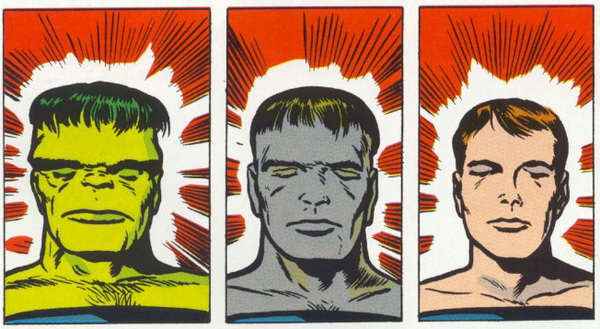
I guess it’s a useful device in that Stan can have Hulk whenever he needs him, but at the same time, it also reduces a lot of the drama that was inherent in Banner not having control over the monster. I’m not sure I’m on board with this new development. I know it won’t last long (at least I don’t think it will), but while it does, it’s just a little too convenient, if you ask me.
2. Whatever happened to the idea developed in the last couple of stories, where Rick Jones is able to control Hulk? I thought that was kind of cool. What happens when you put a “tense teenager” in charge of a mega-strong rage monster? There were so many possibilities in that set-up. I’m disappointed that apparently we’re not going to explore that further.
In this story, Hulk is propelled far enough away that he can no longer receive mental commands from Jones. In the previous story, Jones was able to contact Hulk over a great distance. So this distance must be even further. But the point is moot, because Jones is no longer controlling Hulk, just communicating with him.
3. And what’s this new idea of Banner being able to maintain his intellect while hulking up to super-strength? Yes, it makes him a formidable foe, but again, the drama is diminished. The scary thing about Hulk is that 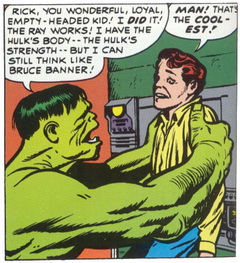 you never know what he’s going to do because he is, as Tony Stark puts it in The Avengers, “an enormous green rage monster,” with the emphasis on “rage.”
you never know what he’s going to do because he is, as Tony Stark puts it in The Avengers, “an enormous green rage monster,” with the emphasis on “rage.”
With Banner in control of Hulk’s brain, we get a lot of talky-talky and too much making sense. It’s kind of like Masterpiece Theatre meets the Tasmanian Devil. Actually, it’s kind of…jarring, and unsettling, to see so many words coming out of Hulk’s word balloon. Once again…just doesn’t work for me.
In fact, there are a lot of things that don’t work for me in this story. Most are minor, yet still jarring. In the retelling of the origin story, Betty Ross is wearing a yellow dress, instead of the pink dress and pillbox hat she wore in the original scene. No biggie. I won’t dwell.
On the missile testing field, General Ross warns his daughter, “Stay back, Betty, this is the weapon…” which leads to the question: what is a civilian doing running out into the middle of a weapons test? However, we’ve already seen that in this world, the military is extremely lax about their procedures involving dangerous weapons. (If they weren’t, we wouldn’t be here!) So even though this is not realistic, at least it’s consistent.
After Hulk rescues the family from the burning house, we see someone on the phone exclaiming that no one will be safe until the Hulk is found. But the rescued family is seen in the background. Are they not going to tell anyone, “Hey, wait! It was the HULK that saved us! He’s not the bad guy you think he is!”
Okay. I can look past that, I guess, because they are probably in shock after everything that’s happened to them. I mean, would you be thinking coherently if a huge green man in purple pants pulled you from a burning building? I think not.
However, there are some MAJOR developments that just don’t sit right with me. At the end of this story, Banner thinks, “even though the Hulk now has my brain, he is still a raging goliath! Still hard to control. I pray he never turns on me…or on mankind…” To which I have to ask…where is this coming from? Does it even make sense? How or why would Hulk turn on Banner? And if he did, how would that work?
At one point, after Hulk turns back to Banner, Rick Jones says, “It’s a relief to have you back, that Hulk was beginning to scare even me.” And in the last panel he worries, “I know the Hulk is still a problem.” But I didn’t see any of that in this story. Why is Rick scared? Where’s the problem? Hulk did good! He was coherent and reasonable. In this story 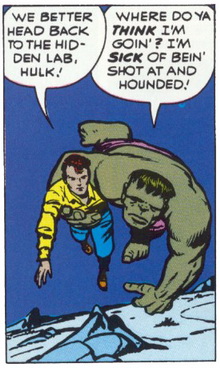 he’s much more “tame” than we’ve seen him thus far. Very little to be afraid of or concerned about.
he’s much more “tame” than we’ve seen him thus far. Very little to be afraid of or concerned about.
To some degree I feel that since the real drama of Hulk being unpredictable and uncontrollable has been watered down by the use of this new machine, Stan is grasping for something to infuse a little drama back into the situation, whether or not it actually makes a whole lot of sense.
One of the main themes that is firmly retained from the original stories is the idea of poor Hulk being persecuted simply because he is a monster. When he says, “I’m sick of bein’ shot at and hounded!” I think, “Ah! Yes! Here is the Hulk I know and love!”
BETTY
And we also still have Betty Ross, though she appears only marginally. Betty is the only one who’s been paying enough attention to begin to figure out that there’s some connection between Banner, Jones and the Hulk. It’s her romantic interest in Bruce Banner and concern for his safety that leads her to share those suspicions with her father. That of course precipitates further complications, but complications are good. They move the story forward.
And now we have moved forward enough that we are ready for the next story in this issue of Incredible Hulk.
GLADIATOR FROM OUTER SPACE
We ended the previous story with the impression that Banner only plans on hulking up when the need arises. Now, in “Gladiator From Outer Space,” the need arises and Hulk is forced out of retirement when “Mongu” lands in his “alien spaceship” and issues a challenge to any opponent able to handle a “two ton ax” in hand to hand combat, or “the warriors of my world will attack this puny planet and conquer it without mercy.”
I’ve purposely used a lot of quotes in that sentence, because once Banner hears the challenge and transforms to Hulk, and he and Rick Jones travel to the the Grand Canyon to meet that challenge, we 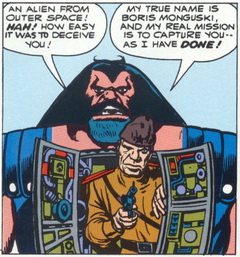 discover that there is no alien Mongu, and this whole thing is a hoax dreamed up by…you guessed it…the dreaded Commies!
discover that there is no alien Mongu, and this whole thing is a hoax dreamed up by…you guessed it…the dreaded Commies!
Yes, folks, it’s the Commies again. This time, it’s a Boris Monguski who informs Hulk that they plan to capture him and take him behind the Iron Curtain so their scientists can study him in an attempt to develop an army of Hulks.
So Hulk and Rick Jones are surrounded by a platoon of gun-wielding Commies in the middle of the lonesome Grand Canyon, and if you think this means the end of Hulk and his tense teenage sidekick, then you haven’t been paying attention. All Hulk has to do is jump in the air, and when he lands, it causes an explosion that causes all the Commie soldiers to drop their guns.
Well, not all their guns, because one Commie is hidden in the “alien spaceship” (which is actually a disguised Mig) and is now using a gun that emits ultra-sonic sound waves that prove torturous to Hulk’s super-sensitive ears.
 But that doesn’t stop him either! Because “Banner’s brilliant brain” works in concert with Hulk’s incredible strength to dig a hole in the ground to escape the piercing noise. He burrows under the aircraft and throws aside the soldier.
But that doesn’t stop him either! Because “Banner’s brilliant brain” works in concert with Hulk’s incredible strength to dig a hole in the ground to escape the piercing noise. He burrows under the aircraft and throws aside the soldier.
But is that the end of it? No, not yet. The Commies threaten to kill Rick Jones unless Hulk cooperates. Rick, of course, very bravely yells to Hulk, “Don’t worry about me!PULVERIZE THESE CREEPS!” because every good red-blooded American boy hates the Commies more than he loves life itself.
But Hulk has no intentions of sacrificing his sidekick. He throws a huge piece of shrapnel at their helicopter. Now, there’s nothing left for the Commies to do but surrender, because “There is a limit to the frustrations which any men can endure—even communists.”
Personally, I think they gave up way too easily…even for communists…but at least the crisis has been averted. Hulk, still utilizing Banner’s brilliant brain, ties all the Commies together with their belts and connects them to the bottom of their disabled helicopter.
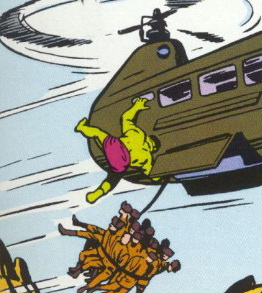
But we’re not done yet! After Hulk and Rick Jones leave (presumably in the chartered “twin engine” plane that brought them there?), a military squad arrives, surveys the scene, with the discarded Mongu “shell” and some footprints and fingerprints that could only belong to Hulk, and ASSUMES that Hulk must have rigged the entire scenario in order to appear a hero.
Okay. Now it’s bad enough that the military comes to this erroneous conclusion, but then the press takes the story and runs with it, plastering it all over the front page. No one seems to care that the facts just don’t add up. If Hulk wanted to appear as a hero, why would he stage this confrontation in the remote location of the Grand Canyon? And why would he leave behind evidence that the entire incident was a hoax?
I can almost forgive the military for jumping to this conclusion, because it’s their job to look for threats, so it’s believable that they would find one where no real threat exists. But I’m extremely disappointed in the press. Is it not the job of the press to seek out and publish the truth? The newspaper headline we see is in the Metropolitan Herald, not the National Enquirer.
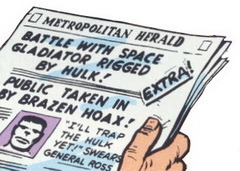
Or am I bringing a post-Watergate mentality to the table? The press of the early 1960’s did not question authority. If the military gives us this story, then that’s what we publish. It was a different world back then, much less cynical. Is that what’s going on here, or is it just too easy a plot device to help perpetuate the feeling among the general population that Hulk is evil and manipulative? Of course, that’s where a lot of the drama in the Hulk stories is coming from right now, so we have to do whatever we can to advance the plight of the misunderstood anti-hero…but even at the expense of making the U.S. military and the “free press” look incredibly prejudiced and stupid?
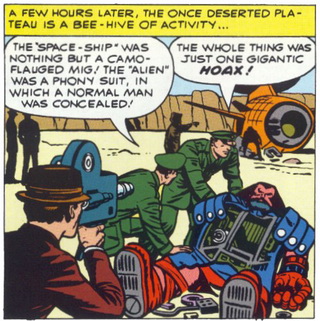 I’m looking at this panel from when the military comes in and finds the “evidence” that Hulk must have set the whole thing up as a self-promotion gig, and I have to wonder…do they not see the huge Mig in the background? Wouldn’t they recognize a Commie aircraft? Does it never occur to them that the Commies might somehow be involved? Or do they hate Hulk even more than they hate Commies? If so, that’s a pretty pervasive hate, because back in the 60’s, no one was more hated than the Commies.
I’m looking at this panel from when the military comes in and finds the “evidence” that Hulk must have set the whole thing up as a self-promotion gig, and I have to wonder…do they not see the huge Mig in the background? Wouldn’t they recognize a Commie aircraft? Does it never occur to them that the Commies might somehow be involved? Or do they hate Hulk even more than they hate Commies? If so, that’s a pretty pervasive hate, because back in the 60’s, no one was more hated than the Commies.
GOT ME!
With that in mind, I wish I could say that when I began reading, I suspected the Commies. But I didn’t. In these early Marvel comics, so far I’ve probably seen the alien threat just about as much as I’ve seen the Commies. But Mongu presented as a very real alien threat at first. There was no reason to suspect that–well…yes, there was, actually. His “spaceship” had landing gear.
 When I first saw that, I did think for a moment… “How odd…” but then as soon as Mongu appeared, I was completely immersed in the alien threat storyline. Got me, Stan! Got me good. Nice work.
When I first saw that, I did think for a moment… “How odd…” but then as soon as Mongu appeared, I was completely immersed in the alien threat storyline. Got me, Stan! Got me good. Nice work.
When Mongu was revealed to be a fake, though, after my first thought of “Doh!” the next thing that occurred to me was: General Ross! This is all part of Ross’ evil plan to get Hulk! That would have made sense, right?
But it wasn’t even Ross. So again I say: Good work! It was a nice surprise to be fooled twice.
And speaking of surprises, imagine my surprise when Rick Jones and Hulk charter a “twin jet” to take them to the Grand Canyon. There are so many things wrong with this picture. First of all, who would be willing to accept a charter flight for the Hulk? Again, I reference a line from the recent Avengers movie, when Banner, believing the ship is about to submerge, wonders “Really? They want me submerged in a pressurized metal container?” Submerged or airborne, it’s the same thing, right? But even if they found a pilot who was just crazy enough to do anything for money, how would the plane lift off the ground with that enormous weight inside?
MYSTERY DATE
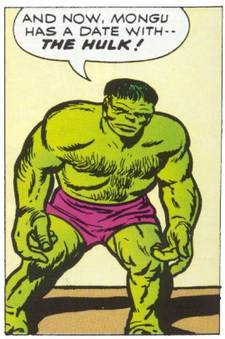
This whole idea of Hulk in a chartered plane really gave me a chuckle. And I also got a chuckle when Hulk proclaims, “And now…Mongu has a date with…the Hulk!” For me, this panel evoked memories of the Mystery Date board game which I played as a child in the 1960’s. I remember that most of the dates behind the door were “dreamboats” ready to take you to the prom, a beach picnic, skiing, bowling. But there was one “dud” with sloppy clothes and dirty face. I’ve got to say, though, that guy’s got nothin’ on Hulk! Hulk brings a new and disturbing dimension to the concept of a dud date!
VILLAIN VALUATION
Well, Hulk may be a dud date, but that’s not as bad as being a Marvel villain, and I think it’s time I added “The Commies” to the villain chart. I’ve resisted so far, because from my 2012 perspective, I don’t really think of Commies as villains so much as simply an international annoyance. But they’re showing up enough that I ought to make at least some general comments about the threat they pose.
In Marvel comics, we have four types of villains: most significantly, the super villains, who have superpowers, and pose a real threat for our superheroes. Next, aliens, who wish to conquer earth. Then, on occasion, we may run into a “thug” or common criminal. I think so far I’ve only encountered 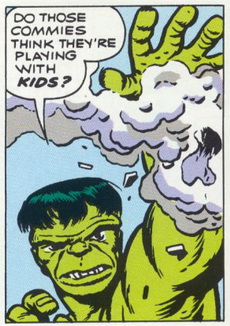 this class of villain in the Spider-Man origin story. The police could take care of these guys, if no superheroes were available at the moment. And last of all, the Commies.
this class of villain in the Spider-Man origin story. The police could take care of these guys, if no superheroes were available at the moment. And last of all, the Commies.
I’ve run into Commies a few times now, and I’m starting to notice a pattern: Commies come on strong, but are vanquished way too easily. (Remember in the last Ant-Man story, all it took was a few ant bites to throw the Commies off their game.) In this story, the Commies have a few tricks up their sleeve, but apparently they have very short sleeves, because one “Whoom!” “E-E-E-E-E-E!” live grenade and disabled helicopter later, they are ready to give up. They surrender Rick, then Hulk uses their belts to tie them to the bottom of their helicopter to send them back to “vodka-land.” With this “vodka-land” jibe, we’ve added insult to injury. Icing on the cake. And this is exactly as it should be in 1960’s America.
![]() So far, our journeys into the Marvelous Zone have taken us from the edge of Atlantis to a far-flung planet, from the other-worldly dimension of Asgard to the dangers of the 17th century. But next time, we’ll visit a land where Yesterday meets Tomorrow.
So far, our journeys into the Marvelous Zone have taken us from the edge of Atlantis to a far-flung planet, from the other-worldly dimension of Asgard to the dangers of the 17th century. But next time, we’ll visit a land where Yesterday meets Tomorrow.
| Want to read this comic on your computer? Marvel has a scan! Want to own this story? Buy the Masterworks! |


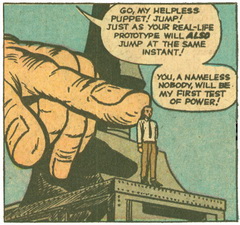 flames on to rescue the jumper. At the same time, we see the Puppet Master attempt to push a doll of a “nameless nobody” from a toy bridge. A flame bursts from his finger, and he realizes that the Human Torch has intervened in his “test.”
flames on to rescue the jumper. At the same time, we see the Puppet Master attempt to push a doll of a “nameless nobody” from a toy bridge. A flame bursts from his finger, and he realizes that the Human Torch has intervened in his “test.” 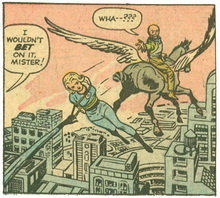 stops her by holding the ankles of a Sue Storm doll.
stops her by holding the ankles of a Sue Storm doll. 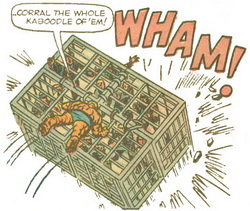 Other prisoners are firing guns, but the bullets bounce off Mr. Fantastic, and he “shoots” them right back “like a sling-shot.” Reed disarms the prisoners, and Torch wraps them in a ring of fire as the warden, returned to his right mind, gets the guards to round up the prisoners.
Other prisoners are firing guns, but the bullets bounce off Mr. Fantastic, and he “shoots” them right back “like a sling-shot.” Reed disarms the prisoners, and Torch wraps them in a ring of fire as the warden, returned to his right mind, gets the guards to round up the prisoners.
 So: craves world domination, in the Plus Column. Manipulates people against their wills—also in the Plus Column. However, his means of manipulation, a radioactive clay, works against him. How much of this stuff does he have? Will it ever run out? What if someone else gets their hands on it? His source of power is not without issues.
So: craves world domination, in the Plus Column. Manipulates people against their wills—also in the Plus Column. However, his means of manipulation, a radioactive clay, works against him. How much of this stuff does he have? Will it ever run out? What if someone else gets their hands on it? His source of power is not without issues.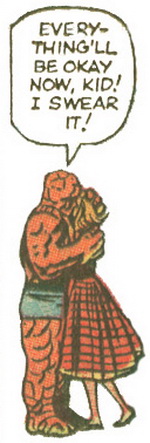
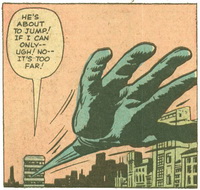 Sue to sleep, and causes her to become visible. Hmmm…. Interesting…. But the bigger question is…how did the Puppet Master know that would happen? Did he read it in Villains Weekly magazine?
Sue to sleep, and causes her to become visible. Hmmm…. Interesting…. But the bigger question is…how did the Puppet Master know that would happen? Did he read it in Villains Weekly magazine?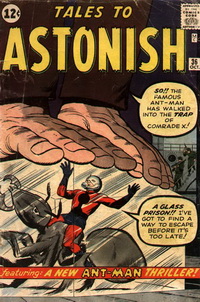
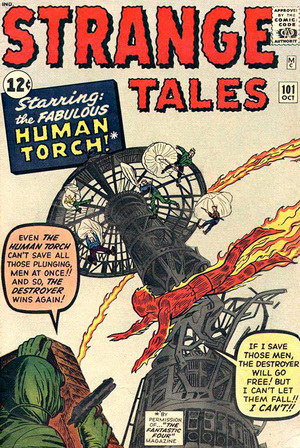
 I really get a kick out of this illusion that the characters had to be invited, hired, or contracted to appear in the new title. I have this image of Stan (much younger, no gray hair, but still with the aviator glasses) sitting at his desk, dialing his rotary phone…
I really get a kick out of this illusion that the characters had to be invited, hired, or contracted to appear in the new title. I have this image of Stan (much younger, no gray hair, but still with the aviator glasses) sitting at his desk, dialing his rotary phone…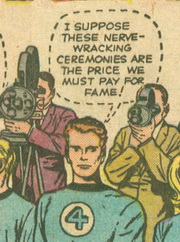 A word balloon that surrounds the text with a broken line indicates the character is whispering.
A word balloon that surrounds the text with a broken line indicates the character is whispering.
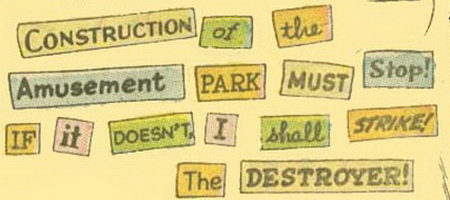
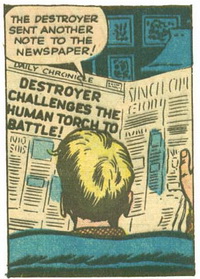 that’s what you do — publish the invite in the newspaper.
that’s what you do — publish the invite in the newspaper.  However, we do get to see some wonderful examples of Marvel teenage boys in suits and ties and hats, so all in all, I would say this little diversion was worth it, just for a chuckle.
However, we do get to see some wonderful examples of Marvel teenage boys in suits and ties and hats, so all in all, I would say this little diversion was worth it, just for a chuckle. 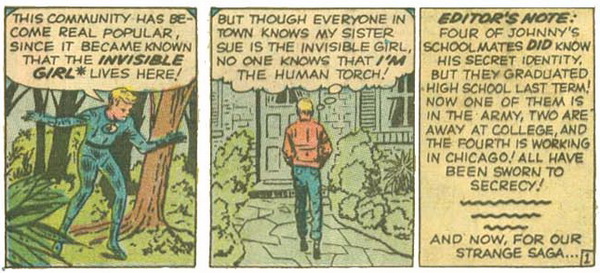
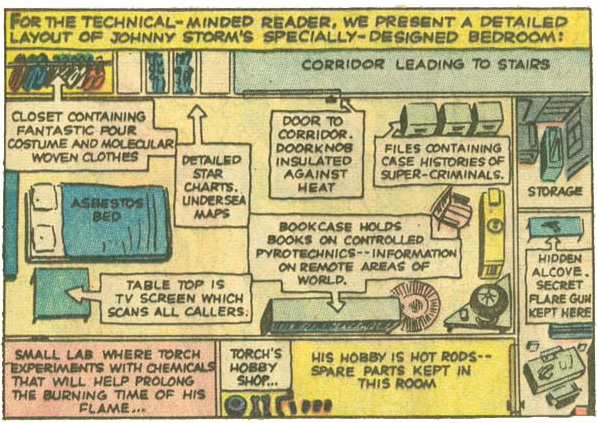 “FOR THE TECHNICALLY MINDED”
“FOR THE TECHNICALLY MINDED”












